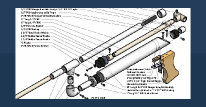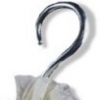The short form:
Here is a metal-free dart head that is made from hot glue in a silicone rubber cast.
![]()
===
Supplies and Materials:
- Silicone putty mix. 1/2 lb made 20 x 3/4" PVC molds. Buy the 1 pound package if you're planning to make molds for sale.
- Hot glue in large quantities from McMasters or Harbor Freight
- Hot glue gun
- Razor blade
- 1/2" or 3/4" PVC
- One or more sets of a 1-1/2" bolt, hex nut, fender washer, and acorn nut of the same thread, either 1/4" or #10.
- A Sharpie
- Some 'slow' adhesive - Shoe Goo, Plumber's Goop, or perhaps Gorilla Glue
===
This is what the final product looks like:
![]()
For those not familiar, acorn nuts look like this:

===
Directions:
- Thread hex nut, then fender washer on bolt, and finally screw the acorn nut on the bolt as far as it will go.
- Drop the fender washer against the top of the acorn nut, then 'unscrew' the hex nut until it is snug against the fender washer, which is snug against the top of the acorn nut.
- Use the Sharpie to mark one face on each the acorn nut and the hex nut that are stacked.
- Using the mark on the hex nut, 'screw' it toward the head of the bolt 5 turns (more if you want a longer post).
- Take the PVC and cut a 1" cylinder.
- Mix enough of the silicone rubber compound to almost fill the PVC cylinder.
- Press the bolt-nut-washer-acorn-nut assembly into the rubber in the PVC by the head of the bolt. If done correctly, some amount will spill out - between the PVC and work surface, between the PVC and the washer, and between the washer and the bolt shaft.
Note: if you are using 1/4" nuts and 1/2" PVC, be very, very careful to keep the bolt centered and straight, otherwise the 1/4" nut may press against the inside of the PVC, ruining the mold.
- (Optional) Take the extra, press it under the rubber compound in the PVC and press again. Repeat until you are confident no air bubbles exist.
- Wait 30 minutes, or whatever the cure time is for your product.
This is what it should look like at this time (1/4" nuts and bolts, 3/4" PVC)
![]()
This is where the "at least one set" part comes in. I would recommend making at least five molds, but you can do it with a single set of nuts and bolt.
- Remove the 'cork' from the PVC. Take the razor and cut down one side of the bolt, the acorn nut, and up the other side.
- Split the two sides and remove the bolt and acorn nut.
- Using the razor, cut an air channel at the tip of the base.
- (Optional) Cut an air channel from the base of the nut 'up' toward the post side.
===
Using the mold
- Place the two mold side-by-side so it looks solid from the top and bottom.
- Insert the 'cork' back into the PVC.
- Insert the hot glue nozzle into the theads.
- S-l-o-w-l-y squeeze the glue into the mold. If you splash it in with a quick squirt, you are liable to trap air bubbles.
- Let glue dry for 5 minutes.
- If you are making solid posts, be aware that hot glue does shrink as it cools. Insert the nozzle into the threads again and slowly squirt two or three drops of hot glue.
===
Using Nutheads without posts
If you wish, you can use nutheads without a matching hole in the foam.
- Cut off the threaded post on the nuthead.
- Melt a hole in the FBR, preferably with a small (<30W) soldering iron.
- Drip hot glue into the melted hole until a solid bubble of hot glue forms.
- Place the head onto the FBR, centered and straight.
===
Using Nutheads with posts
The problem with posted nutheads is that they are very unforgiving in terms of melting a hole. If the hole is off-centered or not straight, the darts will scrape the barrel or otherwise be inaccurate.
- Melt a hole in the FBR, preferable with a small (<30W) soldering iron.
- Drip some slow adhesive in the melted hole.
- Insert the post.
===
Thoughts
---
Data
- My 1/4" nutheads weigh appx 1g each. I lost the #10 acorn nuts that were going to be my next test case, but I suspect they would weigh in the 0.75 to 0.9g range.
- I'm getting about 9-10 each 4" glue stick. This tracks, because 45 x 4" glue sticks is approximately 1 lb, which is appx 450g.
- Out of an unmodded second-gen 4B, I'm getting 130-140'
- The 1/4" of glue in the form of the threaded bolt is very strong. I am unable to pull it off without using my fingernails, or twisting it.
- 5 lbs of hot glue at McMasters costs $38 and generates 2250 darts, so that works out to roughly $0.017 per dart head, so less than two cents each.
- Harbor Freight has 50 x 4" glue sticks for $2.17, which works out to half a cent per dart head.
- This technique can also be used to mold streamline heads, once the head has been filled with something to keep it from collapsing and the hole patched.
---
Negatives (first, because I can't think of many)
- As a whole, we seem to be moving away from glue-domes and toward slugs.
- While easy to make, these tend to be much less forgiving if they are poorly mounted. And a melted hole is a must with these, otherwise they will detach quickly.
- Silicone putty compound is not found at my local Michael's or JoAnn's craft stores. My local Ben Franklin's has it.
---
Positives
- This allows us to create consistent glue dome heads, just like how slugs are mostly consistent (suppliers may vary, centering, yadda, yadda.)
- This allows new dartsmiths to create consistent darts. It makes it easier for newcomers to the hobby to become self-sufficient.
- These darts are much more aerodynamic than slugs. They may even be more aerodynamic than standard glue domes.
- They don't hurt any more than glue domes. Then again, I don't think slugs hurt any less.
- Once the molds are set, the only recurring cost is hot glue, which is readily available, and fairly cheap.
- To alleviate the difficulty in obtaining the silicone putty, someone could make and sell molds. We're still talking about commerce here, but between members of the NIC, which doesn't necessarily have to be internet: someone could buy the putty, make the molds, and sell them at a war, for example.
- Metal-free is much safer. No chance of a BB coming loose, or a washer edge showing.

























